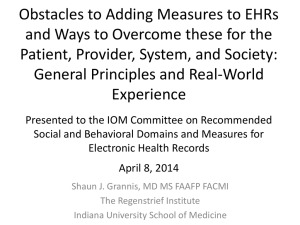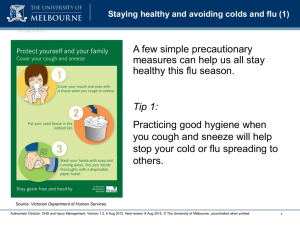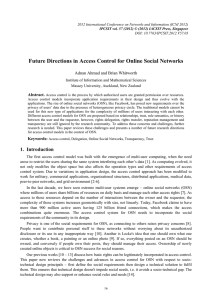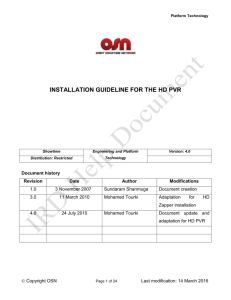ppt - Computer Science - University of Massachusetts Lowell
advertisement
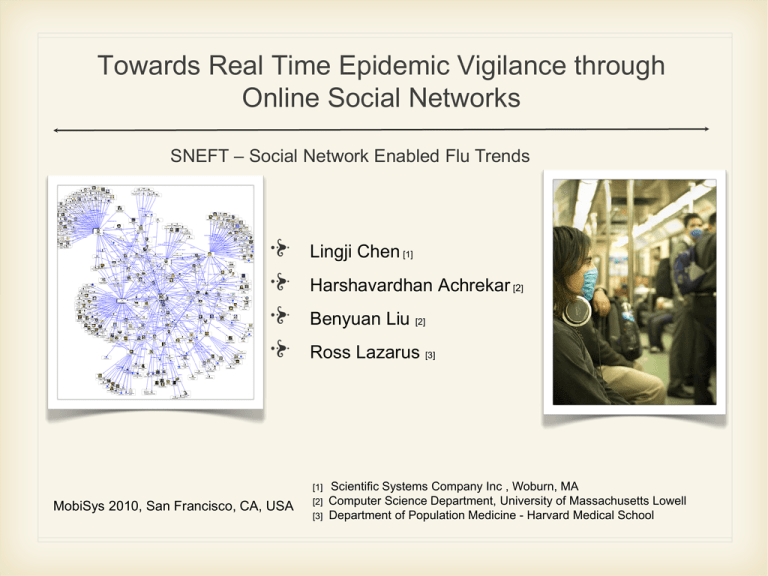
Towards Real Time Epidemic Vigilance through
Online Social Networks
SNEFT – Social Network Enabled Flu Trends
Lingji Chen [1]
Harshavardhan Achrekar [2]
Benyuan Liu [2]
Ross Lazarus [3]
[1]
MobiSys 2010, San Francisco, CA, USA
[2]
[3]
Scientific Systems Company Inc , Woburn, MA
Computer Science Department, University of Massachusetts Lowell
Department of Population Medicine - Harvard Medical School
Outline
Background
Related Work
Our Approach
SNEFT System Architecture
Detection and Prediction
Initial Stage Results
Conclusion
Seasonal flu
•
•
•
•
•
•
•
Influenza (flu) is contagious respiratory
illness caused by influenza viruses.
Seasonal - wave occurrence pattern.
5 to 20 % of population gets flu
≈ 200,000 people are hospitalized from flu
related complications.
36,000 people die from flu every year in
USA.
worldwide death toll is 250,000 to 500,000.
Epidemiologists use early detection of
disease outbreak to reduce no. of people
affected.
Historical Background
Historical Data
Cause
Flu Pandemic /1918 Spanish flu
SARS
Swine Flu/H1N1
overreaction of body’s immune system
SARS coronavirus
Swine Influenza
Virus
Origin USA & France before getting to Spain.
predominant in healthy young adults as
Infected
opposed to juvenile,elderly or weak.
Masses/Areas
Timeline
Infected cases
Deaths
Guangdong, China
USA and Mexico
37 countries including
USA
207 countries
Mar 1918 - Jun 1920 {World war I}
Nov 2002 - Jul 2003
Aug 2009 onwards
500 million
{1/3 of world’s population}
8,273
622,482 so far
50 million (3% of world’s population)
{1.6 billion at that time}
775
15,174 so far
Related Work :- Google Flu Trends
•
•
•
•
Certain Web Search terms are good
Indicators of flu activity.
Google Trend uses Aggregated
search data on flu indicators.
Estimate current flu activity around
the world in real time.
Accuracy of data
{not every person who searches for
“Flu” is sick}
Link:- www.google.com/flutrends
CDC stands for Center for Disease Control
Our Approach
•
•
•
•
•
•
OSN emerged as popular platform for people
to make connections,share information and
interact.
OSN represent a previously untapped data
source for detecting onset of an epidemic and
predicting its spread.
{“i am down with flu”, “get well soon”} msg
exchange between users provide early ,robust
predictions.
Twitter/Facebook mobile users tweet/posts
updates with their geo-location updates. helps
in carrying out refined analysis.
User demographics like age, gender, location,
affiliated networks.,etc can be inferred from
data.
snapshot of current epidemic condition and
preview on what to expect next on daily or
hourly bases.
User Population (in millions)
FaceBook:- 400 ,
Myspace:- 200 ,
Twitter:- 80
System Architecture of SNEFT
Data Collection Engine
downloader
ILI
Data
ARMA Model
ILI
Prediction
Novelty
Detector
Flu
Warning
Filter /
Predictor
State
Estimate
Internet
crawler
OSN
Data
OSN models
Math models
ILI stands for Influenza-Like Illness
Components of SNEFT Architecture
Data Collection
Downloader :- stores CDC ILI data/reports into ILI Database.
Crawler :- collect publicly available data from online social networking sites.
choose a list of keywords that are likely to be of significant.
use OSN public search interfaces to collect relative keyword frequencies.
store relevant information in a OSN spatio-temporal database.
Novelty Detection
Detecting transition from "normal" baseline situation to a pandemic in real time by
monitoring volume and content of OSN data.
provide timely {early stage} warning to public health authorities for investigations.
Components of SNEFT Architecture
ILI prediction / ARMA [Auto-regressive Moving Average] Model
build ARMA model to predict ILI incidence as a linear function of current
and past OSN data and past ILI data.
provide valuable ‘‘preview’’ of ILI cases well ahead of CDC reports.
Integration with mathematical models
Mathematical models to understand dynamics of influenza spread &
effects of intervention. parameters are obtained by fitting historical data.
build an "OSN sensor model" which describes what would be observed on
OSN if the population is infected as such and such."
integrate real time OSN data with the prediction of mathematical models,
to obtain a posterior estimate of the " infected state" of the population.
possible parameter values not consistent with OSN observations are
weighted less, while those consistent are weighted more.
OSN data "sharpen" the prediction of mathematical models.
OSN Data Collection
Facebook
Search
API
Result Set
(Public Posts)
containing
Keywords
HTML
Content
Scrapper
Content , Timestamp
Database
Profile Id
Facebook Profile
Scan Engine
Individual Users
Profile Info , Location Details
Organizations
Community
Design of the Facebook data collection engine / Crawler
Facebook Data Collection / Crawler
Facebook Search Engine
sign-in with a valid account.
enter keyword to search with "Post by
everyone" option to retrieve status
updates and posts of users containing
the keyword.
Result Set containing Keyword
Privacy settings :- user can publish his
post/update to friends, group, or
everyone.
The "everyone" option (default setting)
makes corresponding updates available
to public and searchable by Facebook
search engine.
Results are available for public viewing
for limited time span.
Facebook Data Collection / Crawler
HTML Content Scrapper
a screen scrapper for web pages.
extract useful information out of posts that are returned as result set from the
keyword search.
Search response HTML content is input onto DOM Parser/Regular expression
matcher and techniques of pattern matching are applied.
retrieve
profile ID
time-stamp of the post
post content {with story_id}.
Facebook Data Collection / Crawler
Facebook Profile Scan Engine
Given a profile ID, we will retrieve the detailed information of the profile
name
gender
age
affiliations (school, work, region)
birthday
location
education history
friends count.
Profile last update time.
profile may belong to an individual user, an organization, or a community.
Constraints in OSN Data Collection
Search Rate Limit
Return Result Limit
User Activity Pattern
disparities in user activities
different hours of the day
days of a week
special holidays.
Continuous Data Collection/ prevent Data Loss
schedule search time to guarantee complete set of blog posts containing
the keywords, no gap in the collected data.
Mitigation
Search Rate Limit Constraint Resolution
launch multiple concurrent search sessions from different IP addresses.
to coordinate among themselves and collect data at different time intervals so
that each session is within the search rate limit.
Return Result Limit
continuous http request and store response.
Continuous Data Collection mechanism
Exponentially Weighted Moving Average (EWMA)
scheme in OSN Data Collection
EWMA Scheduling Mechanism to prevent data Loss
volume of returned search results determine no. of active search sessions .
Denote the estimated average and current search result volume at search round k by
v(k) and u(k), respectively, α is the smoothing factor that reflects the weight of the
previous estimate. EWMA(search result volume) is computed as follows:
v(k) = αv(k-1) + (1 - α)u(k)
If the required rate exceeds the rate limit, new search sessions will be triggered to
share the load.
When the search result volume becomes lighter, the number of active search
sessions will be reduced.
Detection and Prediction (SIR Model)
Susceptible-Infectious-Removed (SIR) model where
the dynamics of the population in each compartment
is described by
dS = -βSI;
dt
dI = βSI -ϒI;
dt
Susceptible
Loss of
immunity
Infection
R = N - S - I;
Infectious
N being the total population, β the transmission rate , Removed
ϒ the recovery rate.
let x(t) be the "state" of the population, which in this
case is given by x = [S,I]T . θ be the parameter vector
used in model, which is given by θ= [β,ϒ] T .
Transition Probability of disease spread
Prob(x(t+1) |x(t), θ)
Recovery
(or death)
Initial Stage Results
Conclusion and Future Work
achieve faster and near real time detection.
predict emergence and spread of influenza epidemic.
presented the design of a system called SNEFT, for collecting and
aggregating OSN data, extracting information from it, and integrating it
with mathematical models of influenza.
OSN data - individually noisy but collectively revealing.
potential use - disaster relief, supply chain management , epidemic
vigilance.
Thank You
